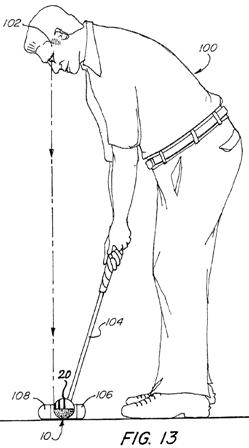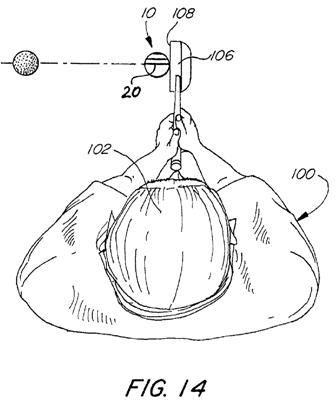Putting Woes? Perhaps this Putting Practice Ball is the Solution
What golfer couldn’t use a little putting help? I just had my first ever putting lesson and it turns out my grip was wrong, my stroke was wrong, and my alignment was wrong, other than that everything was perfect (meaning at least I was holding a putter).
A dedicated putting practice ball may just be what you need to start sinking more putts. One such ball is disclosed in a patent application that recently published as US Pub. No. A golf putting practice ball having visually contrasting lighter and darker sections and a visually contrasting aiming line going across a lighter color section in a 90 degree angle to the borderline of the lighter and darker color sections, and a visually contrasting mark located on the border of the different color sections of the ball, at a location 90 degrees away from the midpoint of the aiming line, and a weight located in an asymmetric position in relation to the internal center of the ball.



The guy in the figures above is in need of a longer putter!
The application goes on to explain:
SUMMARY OF THE INVENTION
[0013] The present invention comprises a practice putting golf ball and method adapted to provide the user with significant and useful visual feedback about the user’s putting stroke. The golf putting practice ball has two visually contrasting parts of the total surface area, one of lighter color than the other being a darker color or black, and a visually contrasting aiming line located on the lighter color half positioned in 90 degree angle to the border between the two halves of different color, and optionally, a second visually contrasting line located on the lighter colored half running parallel to the aiming line. A visually contrasting mark is located on the equator of the ball at a location 90 degrees away from the aiming line. In other words, for purposes of illustration, if the aiming line is located on the equator of the ball, the visually contrasting mark is located at the “North Pole” of the ball. In the preferred embodiment, a weight is positioned off center totally inside the darker colored half of the ball and axially aligned with the aiming line.
[0014] When practicing, a golfer will start by placing the ball on the ground with the aiming line aligned with a line of travel to a hole, and with the visually contrasting mark located on a far side of the ball away from the player; the golfer will position his head over the ball as far as necessary for the golfer to be able to see the visually contrasting mark with the golfer’s one eye directly over the ball; and will execute a putting stroke by hitting the ball with the face of the club in 90 degree angle to the aiming line. The golfer can visually detect whether his/her clubface hit the ball squarely by seeing whether the ball keeps rotating with the aiming line maintaining a recurrent positioning at the top of the ball on every rotation while the ball maintains its directional stability. The player will also get a sense of the power used in hitting the ball by viewing the visually contrasting upper and lower sections as they alternately become visible as during ball rotation, creating a slower or faster pulsating impression depending on the power of the putting stroke used. The user then uses the visual feedback to modify his putting stroke, until the user’s putting has improved.
.
.
.
[0038] Methods of golf putting practice using ball 10 are illustrated in FIGS. 13 and 14, the latter figure seen from an angle from a front angle above the player. The ball 10 is positioned on the ground in front of a user 100 with the aiming line 20 aligned with a line of travel to a hole, and the visually contrasting mark 22 located on a far side of the ball away from the player 100. The player is taking his/her position to address the ball before the putt and bends his/her back and neck in a manner bringing his/her head 102 over the ball, with his/her eyes in a vertical line above the 20, his/her eyes over the ball enough to see the visually contrasting mark 22 on the far side of the ball. The user will keep his eyes on the visually contrasting mark 22 and thereby obtain proper eye and body position for striking the putt. In order to see the visually contrasting mark 22 the player needs to lean over to achieve a position in which his/her head is vertically over the ball, while attempting to achieve such a position without (i) the existence of the visually contrasting mark and (ii) the goal of seeing it, would easily be forgotten or ignored. The result is an increase in the accuracy of the putt by reduction of the likelihood of making a putting stroke where the clubface at the impact is not square in relation to the intended initial desired initial direction of the putt.[0039] A practice putt stroke is executed by moving the club 108 in a path which brings the clubface at impact at a 90 degree angle or square to the aiming line 20 so that the putter head 106 hits the ball with the club face 108 perpendicular to the aiming line 20. To improve his/her chances of making a good putt the player keeps his/her head 102 in the position which enables him/her to see the visually contrasting mark 22 from above and keep it there until the follow through part of the putting stroke is completed.
[0040] Some putting techniques recommend looking at the hole, instead of the ball, and the present invention can be adapted to those techniques if the initial set up of the shot follows the positioning described above, followed by movement of the head to look at the hole, instead of the ball.
[0041] The player 100 visually detects whether his club face 108 hits the ball 10 squarely to provide a correctly aimed putting stroke by determining the degree of directional stability of the primary aiming line 20 (and if present the secondary aiming line 24) while the ball keeps rotating towards its desired direction during the putt. Aiming line 20 and second aiming line 24 provide visual feedback as to the squareness of the putting stroke as the ball 10 rotates. If the putting stroke produces a square impact, the aiming line 20 and second aiming line 24 will appear clear and distinct and remain in a stable directional rotation during the ball’s travel. If the putt stroke is not straight and square, aiming line 20 and second aiming line 24 will go off the intended line losing directional stability.
[0042] The player 100 also visually detects whether his putter 104 hit the ball with the correct force to provide a correctly powered putting stroke by viewing the visually contrasting upper and lower sections 12 and 16 as they alternately become visible as during repetitive ball rotations. The player 100 can use this visu
al cue to estimate ball rotation speed. The alternation of the visually contrasting upper and lower sections 12 and 16 provides the user with feedback on the speed of travel and rotation of golf ball 10. The frequency of change between the visually contrasting upper and lower sections 12 and 16 or the visual impression of pulsation is influenced by the rotational speed of golf ball 10. The harder the ball 10 is hit the faster it rotates and the further it travels, and the higher is the frequency of pulsation of the visual impression experienced by the player. The user 100 can even count the rotations of golf ball 10. This allows the player 100 to make more informed adjustments to putting technique in future play for example by learning that only four and a half rotations are necessary for the ball to travel a distance of two feet, a specially scary length of putt to players suffering of putting yips. As a consequence the player may be able change his/her attitude of the degree of difficulty of the two feet long putt by starting to believe that he/or she needs to make the ball to travel in a desired direction only very few rotations, which with this realization no longer would feel difficult at all, and instead as a task mastering of which anybody should be able to learn quickly with the help of the ball of the invention.
I would buy a sleeve. Now all the inventor needs is an endorser and an infomercial on The Golf Channel!
Dave Dawsey – Watching Golf Putter Inventions
PS – check out additional putter patents HERE
